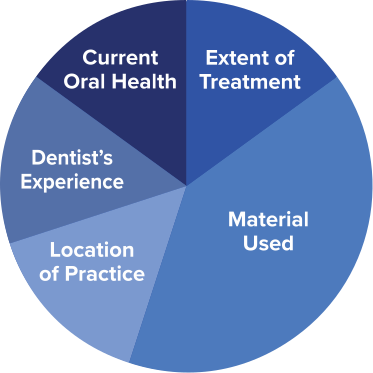Maryland Bonded Bridges
A Maryland bonded bridge is a minimally invasive alternative to a traditional dental bridge, as it does not require extensive modification to neighboring healthy teeth. Developed by researchers at the University of Maryland, this bridge features one or more artificial teeth (pontics) and two small wings. Wings are made of a tooth-colored resin material, so they can attach to the backside of adjacent teeth without affecting the aesthetics of your smile. Typically these restorations are used to replace a single missing tooth. However, Maryland bonded bridges can replace two or more teeth in qualifying cases.
Bridge Design and Placement
The Maryland bonded bridge traditionally featured metal wings and porcelain pontics. Although sturdy, the metal caused the enamel to appear darker and teeth to take on gray tint. Today, the wings are composed of a custom-colored composite resin for more realistic results. To secure the bridge, the supporting teeth are chemically etched to create a strong bond between the wings and teeth. The bridge is then secured with a biocompatible bonding agent.
Who Is a Candidate?
You may be a candidate for a Maryland bonded bridge if you have one to three consecutive missing teeth. To qualify, the teeth on either side of the gap should be healthy and sturdy enough to support the bridge. Your dentist will examine your teeth and gums using x-ray technology to determine whether this form of treatment is right for you.
Traditional Bridges vs. Maryland Bonded Bridges
A fixed bridge features one or more pontics nestled between two dental crowns. These restorations are secured to remaining healthy teeth, known as abutment teeth, on either side of the gap. To create sufficient space for a traditional crown, neighboring teeth must be reshaped. As abutment teeth are altered, this procedure is considered irreversible. If teeth are uncovered, patients can experience significant dental sensitivity and have difficulty eating properly.
With Maryland bonded bridges, remaining teeth are not extensively reshaped, so you can maintain more natural, healthy tissue.
Maryland bonded bridges, however, require minimal alteration to the enamel of adjacent teeth. If ever you want to remove the bridge, a dentist can do so without causing long-term damage.
Understanding the Cost of Maryland Bonded Bridges

There are several factors that can impact the cost of treatment, including the number of teeth treated and the experience of your dentist.
Cost of Maryland Bonded Bridges
Maryland bonded bridges typically cost between $1,185 and $2,340. Each wing costs anywhere from $250 to $550, and replacement teeth range from $685 to $1,240. The overall cost is dependent on several different factors, including:
- Materials used: Although porcelain-fused-to-metal bridges are typically more affordable, composite resin and porcelain bridges are more aesthetically pleasing.
- Number of teeth being replaced: The more extensive the treatment, the higher the cost.
- Condition of your oral health: If you have gum disease, you may require preliminary periodontal care before proceeding with treatment. This can add to the overall cost.
- Dentist’s experience: A more experienced dentist often charges more than a dentist new to the industry. While costs may be comparatively higher, a more qualified dentist can deliver better results and reduce your risk for complications.
- Location of the dentist: Costs are dependent on the location of the dental office. Treatment costs are generally higher in larger metropolitan areas.
As there are many contributing elements, the best way to establish the cost is to schedule a consultation with your dentist. To make treatment more affordable, many dental offices provide in-house payment plans or accept third-party financing.
What to Expect During the Procedure
During your examination, your dentist can assess your oral health needs and review your medical history. You will also have the opportunity to ask any questions you may have regarding the procedure or timeline.
The process typically takes two office visits. The first step involves taking either digital or traditional impressions of your teeth. These will be sent to a professional dental laboratory and used to fabricate your custom bridge. The turnaround time is typically one to two weeks.
When the Maryland bonded bridge is ready, you can return to the office for placement. The dentist can check to ensure the bridge fits properly. If no adjustments are needed, a chemical solution will be applied to the back surface of teeth. A bonding agent will then be used to permanently secure the bridge.
Benefits of Maryland Bonded Bridges
For patients with missing teeth, Maryland bonded bridges can provide an excellent solution. The many benefits of treatment include:
- Realistic aesthetics: These bridges are shade-matched to blend seamlessly with your smile. In addition, porcelain closely mimics the sheen and translucency of enamel for lifelike results.
- Low risk: Remaining teeth are not extensively reshaped, so you can maintain more natural, healthy tissue.
- Lasting results: When properly cared for, these restorations can last for over 10 years.
- Quick and affordable: Maryland bonded bridges take just a few weeks to complete and are typically more affordable than traditional fixed bridges or implant-supported bridges.
- Improved dental function: With the bridge in place, dental function will be restored. You can once again eat, chew, and speak with ease.
Tooth loss can be distressing, especially when it affects teeth close to the front of the mouth. However, once your bridge is secured, you can smile with confidence.
